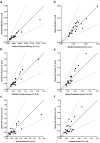Rat as a Predictive Model for Human Clearance and Bioavailability of Monoclonal Antibodies
- PMID: 39846610
- PMCID: PMC11755617
- DOI: 10.3390/antib14010002
Rat as a Predictive Model for Human Clearance and Bioavailability of Monoclonal Antibodies
Abstract
Background: The prediction of human clearance (CL) and subcutaneous (SC) bioavailability is a critical aspect of monoclonal antibody (mAb) selection for clinical development. While monkeys are a well-accepted model for predicting human CL, other preclinical species have been less-thoroughly explored. Unlike CL, predicting the bioavailability of SC administered mAbs in humans remains challenging as contributing factors are not well understood, and preclinical models have not been systematically evaluated.
Methods: Non-clinical and clinical pharmacokinetic (PK) parameters were mined from public and internal sources for rats, cynomolgus monkeys, and humans. Intravenous (IV) and SC PK was determined in Sprague Dawley rats for fourteen mAbs without existing PK data. Together, we obtained cross-species data for 25 mAbs to evaluate CL and SC bioavailability relationships among rats, monkeys, and humans.
Results: Rat and monkey CL significantly correlated with human CL and supported the use of species-specific exponents for body-weight-based allometric scaling. Notably, rat SC bioavailability significantly correlated with human SC bioavailability, while monkey SC bioavailability did not. Bioavailability also correlated with clearance.
Conclusions: The rat model enables an early assessment of mAb PK properties, allowing discrimination among molecules in the discovery pipeline and prediction of human PK. Importantly, rat SC bioavailability significantly correlated with human SC bioavailability, which has not been observed with other species. Rats are cost-effective and efficient relative to monkeys and provide a valuable tool for pharmacokinetic predictions in therapeutic antibody discovery.
Keywords: allometric scaling; bioavailability; clearance; monoclonal antibody; pharmacokinetics; rat.
Conflict of interest statement
J.D.R., K.M.B., A.M.P., L.H., and P.B.-A. are employees of Eli Lilly and Company and have stock and/or stock interests in Eli Lilly and Company.
Figures





Similar articles
-
Pharmacokinetics of 40 kDa Polyethylene glycol (PEG) in mice, rats, cynomolgus monkeys and predicted pharmacokinetics in humans.Eur J Pharm Sci. 2021 Oct 1;165:105928. doi: 10.1016/j.ejps.2021.105928. Epub 2021 Jul 12. Eur J Pharm Sci. 2021. PMID: 34265405
-
Predicting Human Bioavailability of Subcutaneously Administered Monoclonal Antibodies Using Non-human Primate Linear Clearance and Antibody Isoelectric Point.AAPS J. 2023 May 25;25(4):53. doi: 10.1208/s12248-023-00818-1. AAPS J. 2023. PMID: 37225958
-
Minipig as a potential translatable model for monoclonal antibody pharmacokinetics after intravenous and subcutaneous administration.MAbs. 2012 Mar-Apr;4(2):243-55. doi: 10.4161/mabs.4.2.19387. Epub 2012 Mar 1. MAbs. 2012. PMID: 22453096 Free PMC article.
-
A systematic review of allometric scaling exponents for IgG mAbs.Xenobiotica. 2024 Sep;54(9):609-614. doi: 10.1080/00498254.2024.2383925. Epub 2024 Aug 7. Xenobiotica. 2024. PMID: 39067010
-
Pharmacokinetics of monoclonal antibodies and Fc-fusion proteins.Protein Cell. 2018 Jan;9(1):15-32. doi: 10.1007/s13238-017-0408-4. Epub 2017 Apr 19. Protein Cell. 2018. PMID: 28421387 Free PMC article. Review.
References
Grants and funding
LinkOut - more resources
Full Text Sources

